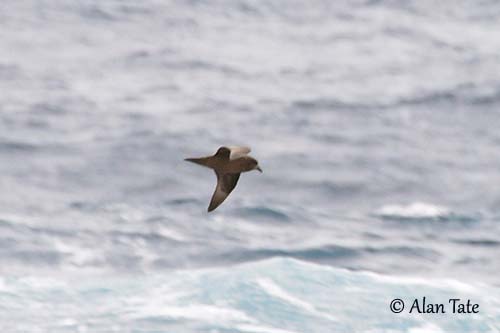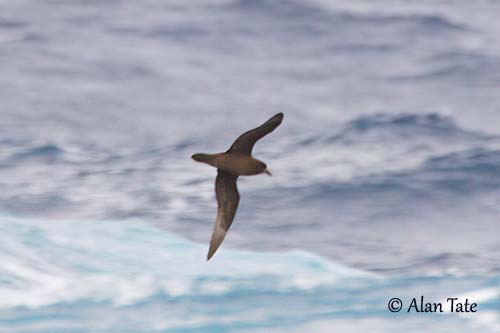
Fr: Pétrel noir
Ang: Great-winged Petrel
All: Langflügel-Sturmvogel
Esp: Petrel Aligrande
Ita: Petrello aligrandi
Nd: Storvingepetrell
Sd: Långvingad petrell
Photographers:
Alan & Ann Tate
AA Bird Photography
Text by Nicole Bouglouan
Sources:
HANDBOOK OF THE BIRDS OF THE WORLD vol 1 by Josep del Hoyo-Andrew Elliot-Jordi Sargatal - Lynx Edicions - ISBN: 8487334105
A Complete Guide to Antarctic Wildlife by Hadoram Shirihai and Illustrated by Brett Jarrett - Edited by Guy M. Kirwan - ALUL.A Press Oy, Finland - ISBN 9519894705
What Bird-The ultimate Bird Guide (Mitchell Waite)
New Zealand birds and birding (Narena Olliver)
Biodiversity Explorer – The Web of Life in Southern Africa
Great-winged Petrel
Pterodroma macroptera
Procellariiformes Order – Porcellariidae Family
INTRODUCTION:
The Great-winged Petrel is now a monotypic species, but it was recently still treated as conspecific with P. gouldi (Grey-faced Petrel).
This dark petrel is highly pelagic and comes ashore only for breeding. It breeds on subantarctic and Antarctic islands where it nests in burrows.
This species is affected by illegal harvesting at colonies, and by mammalian predators introduced to the islands, although several breeding islands are today predator-free.
DESCRIPTION OF THE BIRD:
Biometrics:
Length: 38-40 cm
Wingspan: 97-100 cm
Weight: 385-680 g
The Great-winged Petrel adult is fairly large. It has dark plumage overall, mostly sooty brown with variable paler and greyer area at base of bill.
The underwing appears uniformly dark, but according to the light, the greater coverts are paler and greyer, and a slightly silvery patch is visible at base of primaries.
The wings are long and pointed. The tail is wedge-shaped.
On the dark head, the bill is black with hooked tip. The eyes are blackish-brown. Legs and webbed feet are black.
Male and female are similar.
The juvenile has a pale grey area around the bill and mostly black plumage at fledging.

RANGE:
The Great-winged Petrel is found in Southern Ocean off W Australia and N New Zealand. It breeds on Tristan da Cunha and Gough, Marion, Crozet, Kerguelen and Amsterdam Islands.
HABITAT:
The Great-winged Petrel is highly pelagic and although being widespread, it is sparsely distributed at sea. However, outside the breeding season, they gather at sea off South Africa, usually in deep waters. Densities are less important over the continental shelf.
During the breeding season, it nests in burrows on flat ground, ridges and slopes of several subantarctic islands, between 400 and 1400 metres of elevation.
CALLS AND SONGS: SOUNDS BY XENO-CANTO
Like numerous petrels, the Great-winged Petrel is usually silent at sea, but its nocturnal calls can be heard around the colonies.
It gives sharp, squeaky “kik-kik-kik-kik” or “kee-il kukee-ik” and sometimes a gruff slurred sound “quaw-er”.
At dusk, while flying above the colony, it utters some calls “o-hi” or “o-hoe” whereas loud “or-wik” and soft “si-si-si” are uttered from the ground or inside the burrows.
BEHAVIOUR IN THE WILD:
The Great-winged Petrel feeds at night and mainly on cephalopods, fish and crustaceans caught by surface-seizing and dipping. The squid is the most important source of food for this species.
It often forages alone, but they may form small flocks around abundant food sources. It follows the trawlers and associates with other tubenoses and cetaceans. However, it forms mainly monospecific groups.
The Great-winged Petrel is monogamous and the pairs have long-term pair-bonds. During the breeding season, they defend only the burrow. They breed in loose colonies.
Aerial displays with chases, accompanied by loud calls are performed above the colonies. Inside the burrow, mutual preening and billing are usual courtship displays.
The Great-winged Petrel disperses widely after the breeding season. It can be seen in subtropical parts of Atlantic, Indian and Pacific Oceans. They remain on deep warm waters.
Some vagrants may reach the E coast of South America, to Uruguay and Brazil. However, some birds remain in the vicinity of their breeding islands all year round.
The Great-winged Petrel has rapid flight even in strong winds, performing moderate high sweeping arcs with powerful wingbeats and long glides.

REPRODUCTION OF THIS SPECIES:
The Great-winged Petrel breeds in winter. The birds return to the colonies in late January/February, and perform a pre-laying exodus during several days. It may nest solitary or in loose colonies where they have strictly nocturnal habits.
It excavates the burrow of 60 to 290 centimetres long, but they also use rock crevices when available, or the nest-site is established under the vegetation or in the shelter of tree roots. The nest is lined with leaves and twigs.
The female lays a single white egg in late June/July. The incubation lasts about 51-58 days shared by both parents, usually with three stints of 17 days, with two by the male.
At hatching, the chick has dark brownish-grey down and grey bare skin on the face. It is fed at night with decreasing visits as it is growing up. It fledges between 108 and 128 days after hatching. It will be sexually mature at 7 years old.
PROTECTION / THREATS / STATUS:
The Great-winged Petrel is fairly widespread but it is affected by introduced predators on its breeding islands, threatened by longline trawlers and illegal harvesting at some colonies. However, some breeding islands are today predator-free.
The population is suspected to be declining. The global population is estimated at 500,000 breeding pairs and 1,500,000 individuals across the wide range.
Despite these threats, the Great-winged Petrel is currently evaluated as Least Concern.